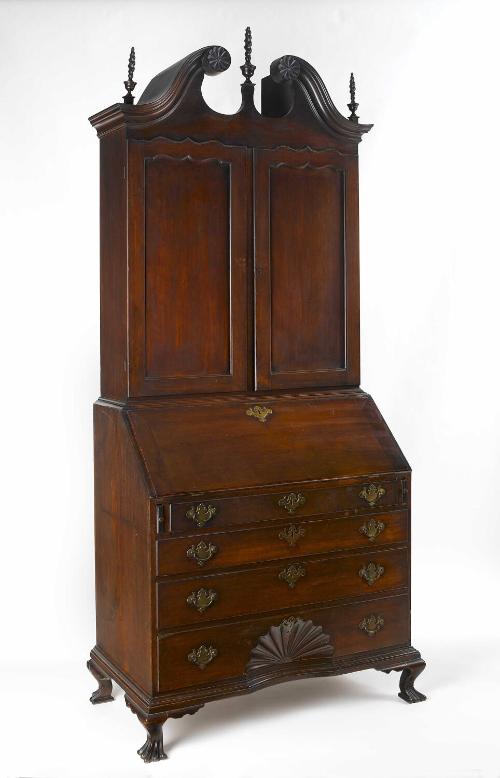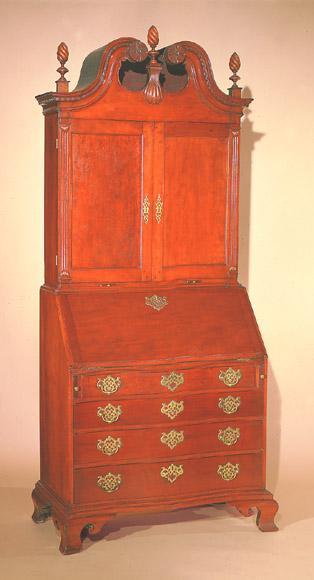Desk and Bookcase
Furniture MakerProbably made by
Ebenezer Hubbell
(American, 1726 - 1812)
Date1760-1780
MediumCherry primary wood, eastern white pine, tulip poplar, yellow pine, butternut, and cedar secondary woods, brass hardware
DimensionsPrimary Dimensions (overall height x width x depth): 97 x 42 3/8 x 23 5/8in. (246.4 x 107.6 x 60cm)
ClassificationsFurniture
Credit LineGift of Helen Elizabeth Royce by exchange
Object number1984.102.0
DescriptionCherry desk and bookcase with a swan's neck pediment in the Chippendale, or rococo style. The desk and bookcase consists of a bookcase in the upper case, over a slant-front desk in the lower case. The swan's neck pediment has a conforming roof, or bonnet top, which is open at the center. Each upper end of the pediment molding terminates in a sunburst rosette. At the top of the desk and bookcase, there are three finials, each in the shape of a flame over an urn. The center finial sits on a raised, curved plinth. The two smaller side finials each sit on a small, raised, rectangular plinth. The top of each bookcase door is shaped with a cyma curve, or S-curve, and a reverse cyma curve. The bottom edge of the pediment is cut to echo that shape. The bookcase fits inside the mid-molding at the top of the desk. The desk arrangement consists of a slant front above four graduated drawers. The top drawer is slightly narrower than the drawers below it, and is flanked by a loper, or thin board that pulls out to form a support for the slant front when open. The bottom drawer is carved with a deep, recessed shell consisting of ten undulating lobes. The recessed shape of the shell extends through to the base molding. The cabriole legs are squat and tightly curved, and each terminates in a Spanish foot. Each foot consists of a central toe flanked by two smaller toes, all resting on a square pad.
The interior arrangement of the bookcase consists of four full-width, fixed, graduated shelves over four shallow drawers in a line; the three lower shelves are divided into compartments by three vertical partitions on each shelf. The vertical partitions are each cut with a shaped front edge, in two different patterns. The bottom shelf forms the top rail of the drawers. The interior arrangement of the desk consists of a central rectangular prospect door flanked by a plain column. To the outside of each column are four pigeonholes in a line over four shallow drawers, stacked two over two. At the top of each pigeonhole is a valance with a lower edge shaped with a cyma curve and reverse cyma curve. The prospect door opens to a compartment with a single, shallow drawer at the bottom. The center section, including the prospect door and the two columns, can be pulled out to reveal hidden compartments. Hardware on each bookcase door consists of a brass keyhole and locking mechanism on the right door, and a latch on the upper interior of the left door. The bookcase drawers each have a round brass pull. The prospect door has a brass lock escutcheon. Each interior desk drawer has a small brass knob. The slant front has a brass lock escutcheon centered at the top edge. Each loper has a round brass knob. Each exterior drawer has a brass, blind lock escutcheon at the top center flanked by a brass escutcheon with a bail pull.
Condition: A portion of the middle toe on the back left foot is missing. The molding on the right side of the pediment is loose. The bookcase doors each have warping in the frame and shrinkage of the panels. The stop is missing from both lopers. The original drawer runners are worn significantly and have been augmented with additional strips of wood nailed to the inner edge. Strips of wood have been added to the bottom of the drawers to correspond to the location of the newer drawer runners. The bottom of the second drawer from the top in the lower case has split. It has been repaired by gluing canvas to the underside on both sides of the split. The interior front corners of the bottom drawer divider have been chipped away. The interior of the desk area has many scratches and stains. The hardware appears to be original.
Design and Construction Details:
Each applied rosette is carved with a ten-petal flower. The bonnet roof ends at the upper end of each pediment scroll, where it is supported by vertical boards; there is no back across the center of the bonnet. The backboards of each case are vertically oriented and are nailed into rabbets in the frame. The bookcase shelves fit into sliding dovetails from the back. The front edge of each shelf has double astragal molding. Each vertical partition on the second shelf from the top has a shaped front edge consisting of a large cyma curve over a small cyma curve. Each vertical partition on the two shelves below that has a shaped front edge consisting of a cyma curve over a reverse cyma curve. The desk sits on a three-sided frame that forms the base molding at the front and sides. The feet are joined to the corners of the frame. The knee bracket returns are relatively deep, providing additional support for the feet.
Drawer Construction. The desk has drawer dividers and drawer runners that fit into sliding dovetails in the case sides. The drawer dividers extend back just over 5 1/2 inches. The drawer runners for the top drawer rest on wood that is nailed to the back of the case, to accommodate the lopers at each side. The drawer dividers, the vertical partitions, and the front edge of the case sides are veneered. The exterior drawers each have a lip-molded edge with ovolo, or thumbnail, molding. The tops of the drawer sides are curved. The drawer bottoms slide into a grooves in the front and sides of each drawer and are nailed at the back. The lower carved shell drawer has an extra block of primary wood nailed to the back of the drawer front, behind the shell. In both the bookcase and the desk, the interior drawer bottoms fit into rabbets in the front and sides of each drawer and are nailed at the back.
Please see attached essay by Dr. Thomas P. Kugelman for more information about this piece.
The interior arrangement of the bookcase consists of four full-width, fixed, graduated shelves over four shallow drawers in a line; the three lower shelves are divided into compartments by three vertical partitions on each shelf. The vertical partitions are each cut with a shaped front edge, in two different patterns. The bottom shelf forms the top rail of the drawers. The interior arrangement of the desk consists of a central rectangular prospect door flanked by a plain column. To the outside of each column are four pigeonholes in a line over four shallow drawers, stacked two over two. At the top of each pigeonhole is a valance with a lower edge shaped with a cyma curve and reverse cyma curve. The prospect door opens to a compartment with a single, shallow drawer at the bottom. The center section, including the prospect door and the two columns, can be pulled out to reveal hidden compartments. Hardware on each bookcase door consists of a brass keyhole and locking mechanism on the right door, and a latch on the upper interior of the left door. The bookcase drawers each have a round brass pull. The prospect door has a brass lock escutcheon. Each interior desk drawer has a small brass knob. The slant front has a brass lock escutcheon centered at the top edge. Each loper has a round brass knob. Each exterior drawer has a brass, blind lock escutcheon at the top center flanked by a brass escutcheon with a bail pull.
Condition: A portion of the middle toe on the back left foot is missing. The molding on the right side of the pediment is loose. The bookcase doors each have warping in the frame and shrinkage of the panels. The stop is missing from both lopers. The original drawer runners are worn significantly and have been augmented with additional strips of wood nailed to the inner edge. Strips of wood have been added to the bottom of the drawers to correspond to the location of the newer drawer runners. The bottom of the second drawer from the top in the lower case has split. It has been repaired by gluing canvas to the underside on both sides of the split. The interior front corners of the bottom drawer divider have been chipped away. The interior of the desk area has many scratches and stains. The hardware appears to be original.
Design and Construction Details:
Each applied rosette is carved with a ten-petal flower. The bonnet roof ends at the upper end of each pediment scroll, where it is supported by vertical boards; there is no back across the center of the bonnet. The backboards of each case are vertically oriented and are nailed into rabbets in the frame. The bookcase shelves fit into sliding dovetails from the back. The front edge of each shelf has double astragal molding. Each vertical partition on the second shelf from the top has a shaped front edge consisting of a large cyma curve over a small cyma curve. Each vertical partition on the two shelves below that has a shaped front edge consisting of a cyma curve over a reverse cyma curve. The desk sits on a three-sided frame that forms the base molding at the front and sides. The feet are joined to the corners of the frame. The knee bracket returns are relatively deep, providing additional support for the feet.
Drawer Construction. The desk has drawer dividers and drawer runners that fit into sliding dovetails in the case sides. The drawer dividers extend back just over 5 1/2 inches. The drawer runners for the top drawer rest on wood that is nailed to the back of the case, to accommodate the lopers at each side. The drawer dividers, the vertical partitions, and the front edge of the case sides are veneered. The exterior drawers each have a lip-molded edge with ovolo, or thumbnail, molding. The tops of the drawer sides are curved. The drawer bottoms slide into a grooves in the front and sides of each drawer and are nailed at the back. The lower carved shell drawer has an extra block of primary wood nailed to the back of the drawer front, behind the shell. In both the bookcase and the desk, the interior drawer bottoms fit into rabbets in the front and sides of each drawer and are nailed at the back.
Please see attached essay by Dr. Thomas P. Kugelman for more information about this piece.
Status
Not on view













